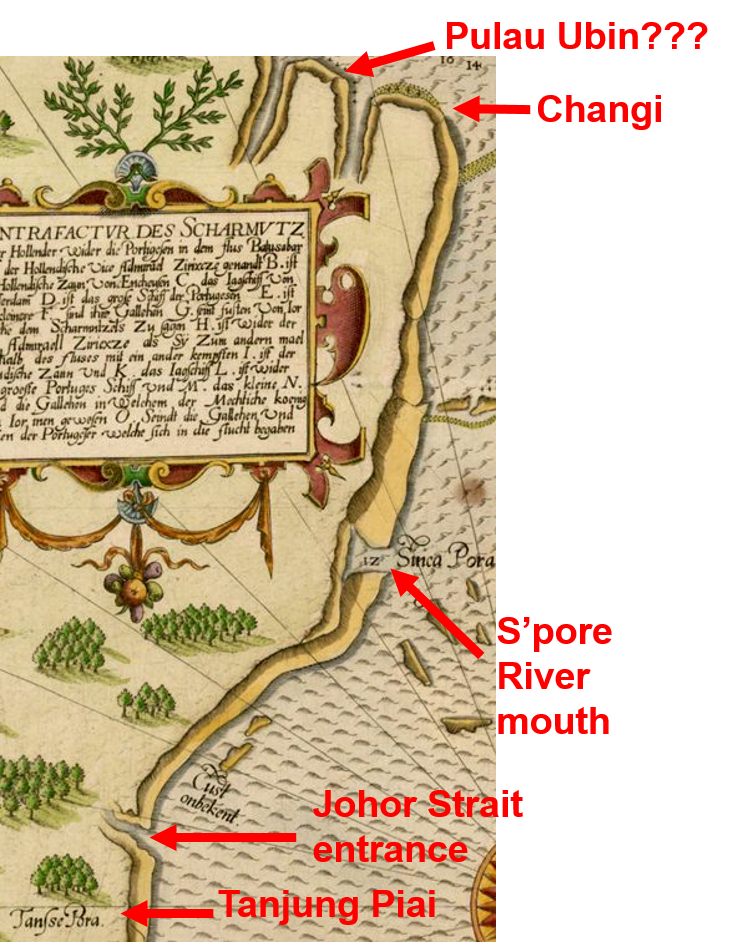To the best of my knowledge, 1613*.
In Manuel Godinho de Erédia's Declaracam de Malaca e da India Meridional com Cathay [1], there is a series of manuscript maps portraying Singapore as an island. These are the first instances where Singapore appears distinctly as an island on a map, instead of as a cape or promontory.
Name: JOR: Regno. [Folio 45R, Declaracam de Malaca e da India Meridional com Cathay].
Year: 1613
Map Maker: Manuel Godinho de Erédia
Manuscript map location: Bibliothèque royale de Belgique, Brussels, Belgium. Ms. 7264.
 |
| Figure 1. (Left) Eredia's map JOR: Regno, where Singapore (SINCAPURA) appears, for the first time, as an island. Source: [2]. (Right) Screen capture from Google map of the area for reference. |
This manuscript map (Fig. 1) is oriented south-north and shows the southern end of the Malay peninsula. It shows an oversized Rio de Jor (Johor River), where the Johor Kingdom (JOR: Regno) is based along. An island labeled SINCAPURA sits at the mouth of the Johor River. Another interesting feature is the island below SINCAPURA which is labeled Pulochagni. This probably means Pulau Changi, and is the old name for Pulau Tekong.
Name: Discripsao chorographica dos Estreitos de Sincapura e Sabbam. Ano 1604. [Folio 61R, Declaracam de Malaca e da India Meridional com Cathay].
Year: 1613
Map Maker: Manuel Godinho de Erédia
Manuscript map location: Bibliothèque royale de Belgique, Brussels, Belgium. Ms. 7264.
 |
| Figure 2. (Left) Eredia's map Discripsao chorographica dos Estreitos de Sincapura e Sabbam. Ano 1604. The island of SINCAPURA appears in the southwest corner of the map. Several place names on Singapore island are labeled (See Fig. 3). Source: [3]. (Right) Screen capture from Google map of the area for reference. |
This map entitled Discripsao chorographica dos Estreitos de Sincapura e Sabbam. Ano 1604 (Chronological description of the Straits of Singapore and Sabbam. A.D. 1604) is a close up version of the the map in Fig. 1 placing the strategically important straits south of Singapore in the centre stage. Several places on Singapore island are also labeled (See Fig. 3 for details). Comparing with the map of the Google map on the right, it is clear that Eredia got the shape of Singapore island wrong. The places labeled on the coast of Singapore island facing the east according to the map, should instead be on the south side of the island.
 |
| Figure 3. Close up view of SINCAPURA island (from Fig. 2). |
The map in Fig. 2 also shows that some of the current familiar place names in Singapore dates back more than four hundred years ago. Here's the list of names labeled in Fig. 3 and their modern names and identifications:
blacan mati : Pulau Blakang Mati, old name of Sentosa island. Although the location of this island on the map does not fit the location of Sentosa island. My guess is that either Eredia got the island wrong, or that another southern island bore the name of Blakang Mati four hundred years ago.
estreito nouo : New Straits. Channel that passes south of Sentosa island [4].
estreito Velho : Old Straits. Present day straits between Sentosa and Singapore island, where Keppel harbour is. The island on the map between estreito nouo and estreito Velho should be Sentosa island.
xabandaria : Shahbandar. (Persian word for harbour master). Settlement around the shahbandar official loyal to the Johor sultanate. The location is either near the mouth of Singapore River or Kallang basin [5].
Tanjon Rû : Tanjong Rhu
Sunebodo : Sungei Bedok
Tanamera : Tanah Merah
Tanjon Rusa : Tanjong Rusa. Obsolete place name. Probably present day Changi Point.
Turucan: Terusan (Malay word for Channel)
Salat Tubro : Selat Tebrau (Tebrau Straits that separates Singapore and Malaysia)
Pulo Ular : Pulau Ular (Snake island). Now known as Pulau Merambong
Manuel Godinho de Erédia (1563-1623) was born in Malacca of Ibero-Bugis parentage. Educated in Malacca and Goa, he was commissioned in 1594 as the Descobridor e Adelantado da Nova India Meridional. His assignment was to set out from Malacca to discover for Portugal, new lands south of the East Indies. However, that did not quite work out.
Right during that time, the Straits of Malacca became a geopolitical hotspot as the Dutch became active in the region. The Dutch, allied with the Johor Sultanate, were challenging the Portuguese dominance of the Straits of Malacca. Instead of setting out to explore the unknown seas, Eredia had to help out with the fortification and survey of the region. This led to a more detailed exploration of the strategically important waters around Singapore.
This new information gained, together with the new maps drawn were eventually written up by Eredia in 1613 as his Declaracam de Malaca e da India Meridional com Cathay, more commonly known as Description of Malaca.
*Added 24th Sept.: There are several manuscript maps dating from the 1530s onwards that show Singapore as an island, but unnamed. See this entry.
References
[1] J. V. Mills, "Description of Malaca, Meridional India, and Cathay. Translated from Portuguese with notes". JMBRAS 8, 1 (1930).
[2] ibid. Plate III, after p. 218.
[3] ibid. Plate VI, after p. 224.
[4] P. Borschberg, The Singapore and Melaka Straits: Violence, Security and Diplomacy in the 17th Century (NUS Press, Singapore, 2013) p. 31
[5] ed. P. Borschberg, trans. R. Roy, The Memoirs and Memorials of Jacques de Coutre: Security, Trade and Society in 16th- and 17th-century Southeast Asia (NUS Press, Singapore, 2013) p. 378.





























